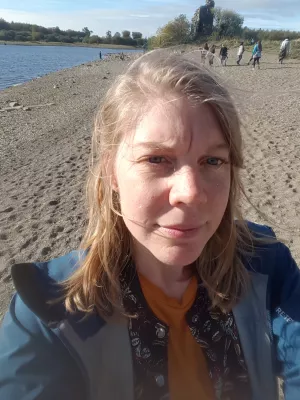
Veronica Hederström
Researcher

Ecology of pollinators, pests and natural enemies in agricultural landscapes : ensuring a sustainable supply of clover seeds
Author
Summary, in English
The human population and its food consumption continues to grow and the environmental impact of meeting future food demands depends on how we expand the food supply. Already, agricultural intensification has led to biodiversity declines, which in turn can have direct and indirect effects on agricultural production. For future sustainable production there is a need to support ecosystems and their ability to provide ecosystem services. To do so, we need more knowledge on how functional insect groups such as pollinators, pests and natural enemies are affected by land use, and how they in turn affect agricultural systems and crop yields.
Due to their ability to fix atmospheric nitrogen, clovers are grown worldwide for animal feed and for green manure. Clover is an important crop in organic farming where inorganic fertilizers are prohibited. However, producers of clover seeds are experiencing problems with varying yields. In this thesis I, therefore, investigated important factors affecting seed yield. I studied interactive effects of plant and pollinator traits on seed set in red clover in a common garden, and investigated spatiotemporal patterns of pollinators, pests and natural enemies in agricultural
white clover seed fields. I found that pest abundance in white clover fields decreased with distance from the previous year’s field. Furthermore, pest abundance increased, whereas parasitism rates provided by natural enemies decreased, with proportion arable land in the surrounding landscape. These results point to the potential for using spatial planning as a pest management tool in clover seed production. Abundance of pollinating non- Apis bees was higher in conventionally managed fields compared to organic fields, and abundance of honey bees and total number of bees in organic fields were negatively related to proportion semi-natural land. If these observations are due to more preferable habitats elsewhere needs further investigation. I further showed that white clover fields do not always have sufficient amounts of pollinators as previously believed. In white clover, short tongued bees are good pollinators, but in red clover, and especially tetraploid cultivars, flower visits by medium- or long-tongued bees resulted in a higher seed set. Unexpectedly, medium- tongued bees on a diploid red clover cultivar gave much higher seed set than other combinations of bee tongue length and clover ploidy. This shows the importance of a diverse pollinator fauna, as different pollinators are unequally able to pollinate different species of plants.
Due to their ability to fix atmospheric nitrogen, clovers are grown worldwide for animal feed and for green manure. Clover is an important crop in organic farming where inorganic fertilizers are prohibited. However, producers of clover seeds are experiencing problems with varying yields. In this thesis I, therefore, investigated important factors affecting seed yield. I studied interactive effects of plant and pollinator traits on seed set in red clover in a common garden, and investigated spatiotemporal patterns of pollinators, pests and natural enemies in agricultural
white clover seed fields. I found that pest abundance in white clover fields decreased with distance from the previous year’s field. Furthermore, pest abundance increased, whereas parasitism rates provided by natural enemies decreased, with proportion arable land in the surrounding landscape. These results point to the potential for using spatial planning as a pest management tool in clover seed production. Abundance of pollinating non- Apis bees was higher in conventionally managed fields compared to organic fields, and abundance of honey bees and total number of bees in organic fields were negatively related to proportion semi-natural land. If these observations are due to more preferable habitats elsewhere needs further investigation. I further showed that white clover fields do not always have sufficient amounts of pollinators as previously believed. In white clover, short tongued bees are good pollinators, but in red clover, and especially tetraploid cultivars, flower visits by medium- or long-tongued bees resulted in a higher seed set. Unexpectedly, medium- tongued bees on a diploid red clover cultivar gave much higher seed set than other combinations of bee tongue length and clover ploidy. This shows the importance of a diverse pollinator fauna, as different pollinators are unequally able to pollinate different species of plants.
Publishing year
2019-04-03
Language
English
Volume
2019:23
Links
Document type
Dissertation
Publisher
Swedish Agricultural University
Status
Published
Supervisor
- Mattias C. Larsson
- Åsa Lankinen
- Göran Birgersson
- Maj Rundlöf
- Olle Anderbrant
- Glenn Svensson
ISBN/ISSN/Other
- ISBN: 978-91-7760-365-8
- ISBN: 978-91-7760-364-1